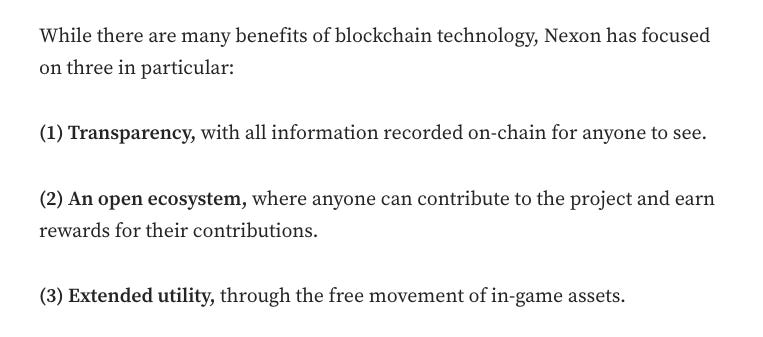Unpacking Maple Universe, the First Serious Web3 Game
Can the fun of DeFi be translated into mainstream gaming success?
The most common critique of web3 gaming is that it isn't fun.
Of course fun is very subjective. Crypto natives have a very different version of fun than regular gamers.
What we usually mean by fun is something akin to profitable – sustainably addictive for mainstream audiences at scale.
But when a known IP like Maple Story (>$3B in lifetime revenue) decides to build a crypto-native version of their game, this objection goes away.
The Nexon team not only understand that they've built a fun game, they know what's fun about it and see the synergies with crypto: notably they call it RX or the reward experience.
As someone who played Maple Story in my childhood, I'm excited for them to try and build a crypto game that could achieve mainstream levels of adoption.
But what’s particularly interesting is that the Maple Story team are seasoned mechanism designers, designing an in-game economy for over a decade.
This is clearly not just an experiment but a bet on where they expect gaming to go.
What follows is a quick run-down of the key mechanics of Maple Story as revealed so far and my conclusions about what Nexon sees as the key to web3 gaming success.
Why Maple Universe
Two decades of game development led them to appreciate the value of longevity and permanence and to seek out web3 technologies:
They cite 3 benefits of using crypto in a gaming context:
Of course, we are already familiar with these in crypto under slightly different terminology: trustlessness, incentive-alignment and composability.
Items in Maple Story N are finite and scarce
From the get-go, Maple Story N embraces scarcity.
In-game items will leverage NFT collections with fixed supply just like we are familiar with.
In early testing, this wasn't as user-friendly as they hoped.
Beginner players felt overwhelmed because a limited supply system is a competitive system (also known as “PVP” in crypto circles).
So instead players can initially acquire some infinite supply items that are not upgradable, then pursue off chain items and finally try to acquire true onchain items that are represented as NFTs (similar to the approach pioneered by Gods Unchained and other web3 games):
To see how this actually works, we have to refer to the “whitepaper” (actually a comic:
Dynamic Pricing of Enhancements
While items are scarce, enhancements of items are not… sort of.
However, the Maple Story team still wanted enhancement pricing to be market-constrained.
What they came up is a bonding curve approach.
Price drops by 5% each minute until a user buys an enhancement.
What's interesting is that they have already observed emergent behavior as players adapt to this reality:
To some players, this will be a fun introduction to financial markets but I'm curious how they overcome the fact that the later a player joins the game the more difficult it will be to acquire certain items and therefore potentially less motivating.
Tracking and optimizing for demand can leave to power curve outcomes with most demand being driven by guild-like organizations which could jeopardize the funnel of new players onboarding.
Enhanced items could then be traded normally on the marketplace:
As another example of just how Maple Story “gets it” is their illustration of how crypto enables anyone to build composable experiences using the same in-game items:
Vice versa, they are considering incorporating non-Maple Story related NFTs into the game:
Maple Universe will even trust contributors to develop in-game items and reward them accordingly:
Maple Universe is inherently multiversal
The simplest expression of this is that items can be interpreted differently in different worlds.
And worlds can be created by different users/teams.
While I appreciate just how clearly the Nexon team has articulated and are starting to implement the benefits of crypto, there is something bigger happening here.
They are ripping up Maple Story and replacing it with DeFi.
Crypto natives often joke around that crypto is a game.
Our journeys trying to acquire limited items are deeply analogous to the RX (reward experience) that Maple Story is optimizing for.
When I looked at their economics, I actually expected them to lean only into composability.
Instead, they've fully embraced scarcity and the financialization of in-game items which is a much bolder bet.
It’s a bet that the PVP experience of crypto is more fun than Nexon's best idea of where the web2 version of the game could go.
Perhaps what we are learning is that web3 games don't need to become fun.
They just need to embrace more aspects of DeFi, NFTs and other “serious” applications of crypto.
That’s not a thesis I thought the first major crypto game would be built upon but I'm excited to see how it plays out.


















